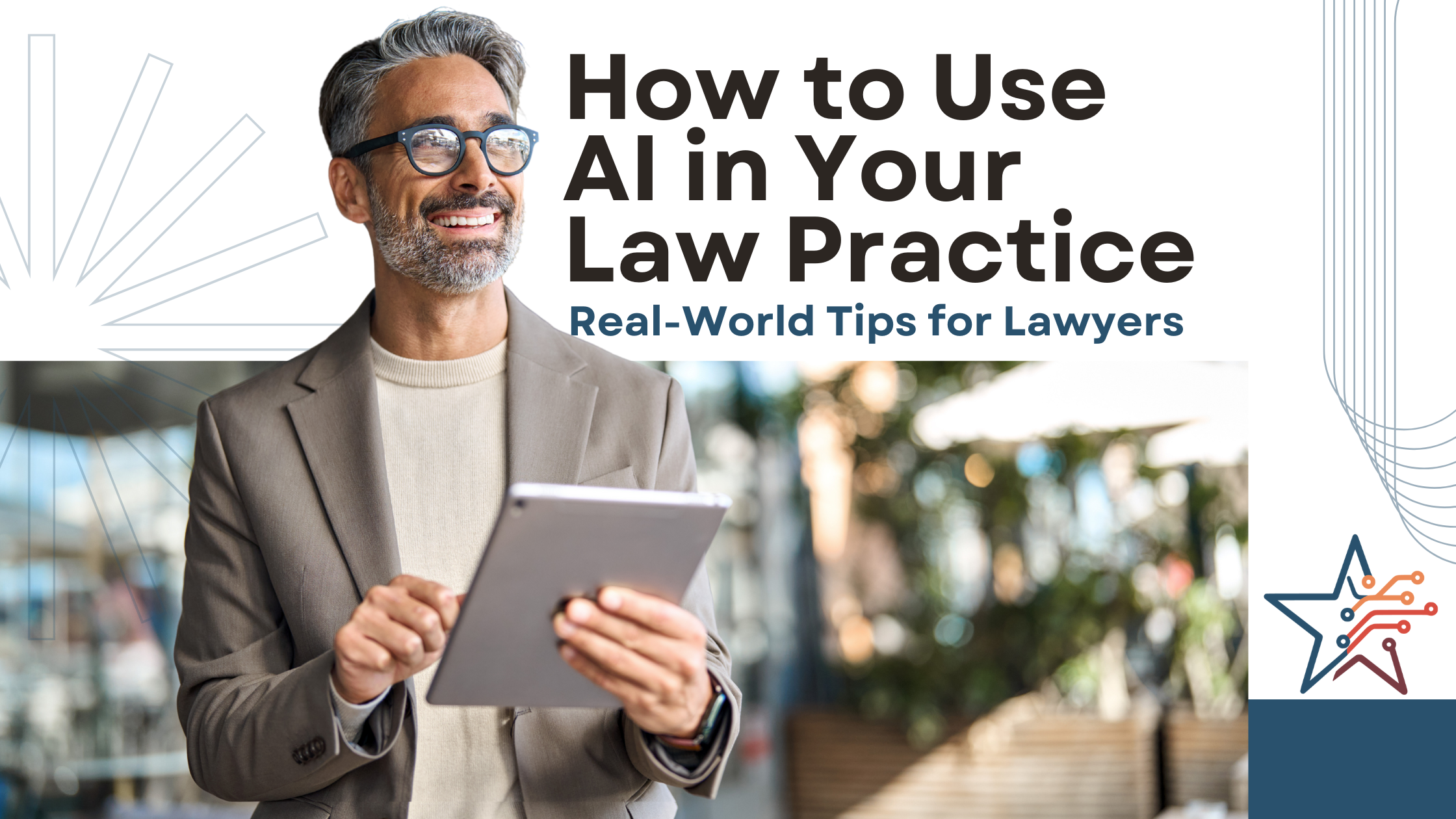How to Use AI in Your Law Practice: Real-World Tips for Texas Lawyers
Published on July 9, 2025 Lawyer Life Law Practice Tips

Artificial intelligence continues to evolve, becoming more user-friendly and applicable to the practice of law. Whether you're already using AI in your law practice or you're considering it, you need to be aware of the potential pitfalls and obstacles that may crop up when implementing and using these tools.
Recently, the State Bar of Texas' Taskforce for Responsible AI in the Law (TRAIL) published the AI Toolkit. This toolkit is a comprehensive guide for lawyers, legal assistants, and judges. In this blog post, we will highlight the sections of the toolkit and provide a brief overview on what you need to keep in mind during every step of the AI implementation process.
Remember, AI is a tool just like any other tool or software you might use in your law practice. It is not a magic solution to all your problems. As such, you must treat AI the same way you'd treat any other piece of software.
From understanding the risks to vetting vendors, here is what Texas lawyers should keep in mind when implementing AI tools in their law practices.
Before Implementing AI Tools in Your Law Practice
As exciting as AI may seem, legal professionals must understand the obligation behind ethical use of AI given the potential liabilities and risks it poses. The following sections correspond more to in-depth chapters in the AI toolkit, so make sure to check out the toolkit for further guidance and insight.
Ethics and Professional Responsibility
The ethical and responsible use of AI tools in the legal field is paramount. Opinion 705 from The Professional Ethics Committee for the State Bar of Texas highlights this responsibility, addressing "how Texas attorneys can ethically use generative artificial intelligence in their practice" and clarifying the myriad ethical considerations lawyers need in order to use AI tools safely and effectively.
Below are the ethical responsibilities lawyers should be aware of before implementing AI tools in their law practice.
- Understand generative AI: Attorneys have a duty to maintain technological competence and must independently verify results generated by generative artificial intelligence (gen AI). Always substantiate the results.
- Protect client confidentiality: Gen AI tools require vast amounts of data to function properly. When it comes to inputting client data, it's crucial to practice as much caution as possible. You don't want to inadvertently disclose confidential client information. To protect client confidentiality and mitigate potential risks, it's best to properly vet the gen AI tools you're considering using. Ensure your staff is compliant with confidentiality rules and properly train them on how to use the tools correctly and safely.
- Always verify AI outputs: When it comes to using AI, you should always verify the outputs/results. Never trust blindly. AI can easily make mistakes. While these tools are meant to streamline work, they are not 100% infallible and errors can still arise. As such, make sure to double-check all gen AI-generated content before use in client matters or court submissions.
- Practice fair and ethical billing: When applied and used correctly, gen AI can reduce your workload. As beneficial as this can be for your firm's internal processes, it's necessary to pass the timesaving along to your clients as well. Only bill clients for the actual time you spent working on their case. Make sure to communicate with your clients clearly on any gen AI-related fees or subscriptions that may be billed to them.
For a deeper look at ethics and professional responsibility, check out the AI Toolkit.
Liability and Risk Management
Using AI tools can be highly beneficial, but it can also be very risky. As such, attorneys must implement effective risk management practices.
Note, however, that not all AI tools carry the same degree of risk. Some tasks, such as scheduling or workflow management, pose low levels of risk as the data the AI tool uses is unlikely to be confidential, and the tool’s results and outputs can be easily verified.
Other tools such as those used for research and document drafting pose the highest risk. When using these AI tools, independent human verification is required to ensure accuracy and compliance.
Some of the most common AI-related liabilities and risks lawyers may face include:
- Errors and inaccuracies
- Confidentiality breaches
- Bias and discrimination
- Over-reliance and failure to supervise
- Failure of communication and informed consent
- Billing irregularities
Data Privacy and Security
When it comes to using AI-powered tools in your law firm, it’s crucial to employ secure data privacy and security practices. This should be true for any new tool or piece of software you use in your firm, but it’s even more important when it comes to AI tools. AI tools are “data intensive” which means they require high amounts of data to function properly. You can see where the potential issues lie.
While the Data Privacy and Security page of the AI Toolkit goes into much more detail on this topic, attorneys should follow these guidelines to ensure data privacy compliance:
- Update privacy notices
- Vet vendors carefully
- Negotiate contracts
- Strengthen internal security
- Conduct privacy training
- Plan for incidents
To learn more about key data privacy considerations for AI use, visit the AI Toolkit.
When Preparing to Implement AI Tools in Your Law Practice
Now that you have a clear understanding of the risks, professional responsibilities, and data privacy and security hurdles that AI tools pose, you can move on to the next steps: AI tool procurement and vendor selection.
First, ask yourself if the AI tool is necessary or useful in your specific practice area. In the practice of law, AI tools can be used to streamline repetitive tasks such as timekeeping, billing, document drafting, and routine workflows. Take a closer look at how you run your law practice. If you notice certain areas that could be more productive, there may be an AI tool that can help streamline the process.
As stated previously, AI tools can be prone to inaccuracies and overly burdensome if not implemented properly. As such, it’s best to start off with one tool. This way, you can devote enough time to understanding how it works. If you take on too many AI tools at once, it may be difficult to ensure they’re all being used as efficiently as possible. Not only will this result in wasted time and higher costs, but it may lead to potential risks and data privacy concerns.
Finding the Right AI Vendor
Thoughtful procurement and implementation of AI tools requires:
- Thorough evaluation of the AI tool, and
- Consideration of the data requirements and resource allocation.
Hiring an AI vendor (or vendors) to implement AI tools in your law practice requires careful consideration. There are many vendors offering AI tools specifically for lawyers. In fact, the market may seem oversaturated with vendors who use terms like “AI-powered” or “AI-based” when advertising their products.
As such, it’s a good idea to keep an open mind and ask as many questions as you can before choosing a vendor. A great question to ask is, “Why specifically does the technology you use in your product/service/software need to be AI?”
This question will give you deeper insight on how the vendor is actually using the technology. You’ll then be able to separate the vendors who leverage AI to make their product as beneficial and useful as possible from those who are simply using AI in their messaging as nothing more than a marketing buzzword.
For an excellent overview of AI procurement and how to speak to potential AI vendors, watch this video from AI Taskforce member and TOJI Director Joshua Weaver
By carefully evaluating the tools and understanding potential obstacles, you’ll be able to make the right choice for your law firm and your clients. And speaking of clients…
Talking to Your Clients about AI
Once you’ve found the right vendor and you’re ready to start using the AI-powered tools in your law firm, it’s necessary to communicate with your clients about how the technology will be used. By being transparent, you’ll be able to maintain your clients’ trust and manage expectations.
While the AI Toolkit chapter on client communication goes into much further detail on this topic, here is a concise list of what to disclose when communicating to your clients about AI.
- Intended Use: Explain how AI-powered tools might be used in client-specific matters.
- Benefits: Articulate the advantages, such as increased efficiency, faster turnaround times, and potential cost reduction.
- Risks and limitations: Be clear about the potential downsides and explain issues that may arise with confidentiality, accuracy, and bias. Make sure to communicate the safeguards that will be implemented to mitigate these risks.
When speaking with clients about AI, being clear and understandable is paramount. Avoid using technical jargon. As always, maintain a professional and reassuring tone. Highlight how the AI tools are being used under your control and supervision. By keeping your clients informed and being open with them about any changes regarding how you’ll use AI tools, you’ll be able to collaborate more effectively and avoid future issues.
Take Your Law Practice to the Next Level with AI
AI-powered tools are here to stay. If you’re ready to implement artificial intelligence in your law practice (or you’re already using AI but would like to improve efficiencies), check out the State Bar of Texas’ AI Toolkit. The toolkit provides answers to some of the most prudent questions when it comes to AI in the legal field. It also features videos from members of the State Bar’s Taskforce for Responsible AI in the Law (TRAIL) as well as external sources such as AI-focused articles, guides, tools, and CLE programs. If you have a question about AI use, odds are the AI Toolkit has the answer you’re looking for.
Remember, AI is a tool. With the right insight and care, you can use it to your advantage.

Otto Nicli
Otto Nicli is part of the State Bar's Web team and serves as the blog writer for the Texas Bar Practice website. He also plays a part in marketing and video production. In his free time, he enjoys watching Top Chef with his wife, collecting records, reading, and going to shows.